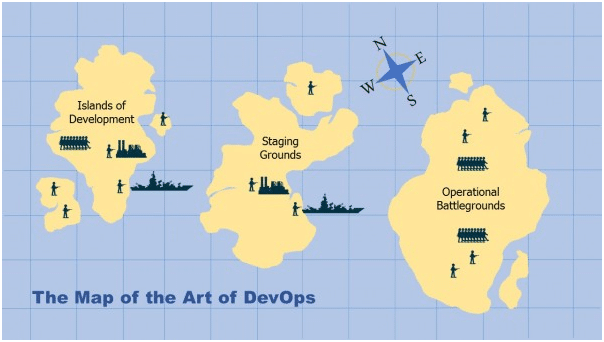Understanding the DevOps Landscape
We have a passion for DevOps and with good reason! It’s been overwhelming to see how the industry has accepted DevOps as a futuristic norm for faster and better deliverables. In this blog, we explore the DevOps landscape and give you an inkling of what tectonic shifts can be expected in them.
Brett Hofer, in one of his recent posts ‘The Art of DevOps: An Introduction to Landscape’, approaches the Art of Devops as a battlefront: “What are we fighting for here?” he asks “Ultimately, we’re fighting for the absolute best services and features that we can deliver to our customers as quickly as we possibly can, and to eliminate the “War Room” scenario we are all so familiar with.” He explains the DevOps landscape by means of the three stages mentioned in the diagram below.
We will tread on the same lines of development, which are automated testing and final deployment, to understand the DevOps landscape.
Islands of Development – Continuous Development
Continuous Development is the foundation stage of DevOps. It is at this stage that the development and operations team needs to communicate and integrate each step to ensure that the project gets a good head start and that organizational goals are achieved. The onus of this basically lies in the hands of the project manager as he plays a key role in ensuring that operational goals are well defined and met. Included in this stage is creating the right environment to kick start the project as well as the right infrastructure to develop software, test, and deploy it successfully. Research, building, and setting up the assets and development team is part of this stage. There are different stages within the development process itself that need to be carried out meticulously until the final product is ready to move to the next stage of testing.
Staging Grounds – Automated Testing
Software is rigorously tested in this stage to weed out any issues related to performance, security, UI, high concurrent use, and so on. The primary goal at this level is to dig out any glitches that might have been overlooked at the development stage. A risk analysis is done to show how each software issue is handled as it may affect other aspects of the software and the overall operation. We have discussed in detail the various benefits of automated testing in our previous blogs, so we will not get down to great detail here. Easier, faster, and better is what it is!
Operational Battleground – Deployment
This is the frontline, right into the war zone. Getting your software market ready! By the time the software has reached this stage, a considerable amount of time and money has been invested. It is time for final checks and suiting up. When all the testing has been done, the software should behave perfectly on your computer, smart phone or tablet. This does not mean it will behave the same way when it is given to others. Thus, careful and strategically thought out moves are the key.
That’s a look at the landscape of DevOps. It depends more on continuous communication and feedback across all three functions. Case studies on perfected battle moves are also essential. Whatever the case, the DevOps landscape is continuously changing right with it. Join us as we get into greater detail in the next few blogs.






Leave a Reply